 |
| Category:
Assorted |

|
|
|
|
|
|
The Dogs of War
|
|
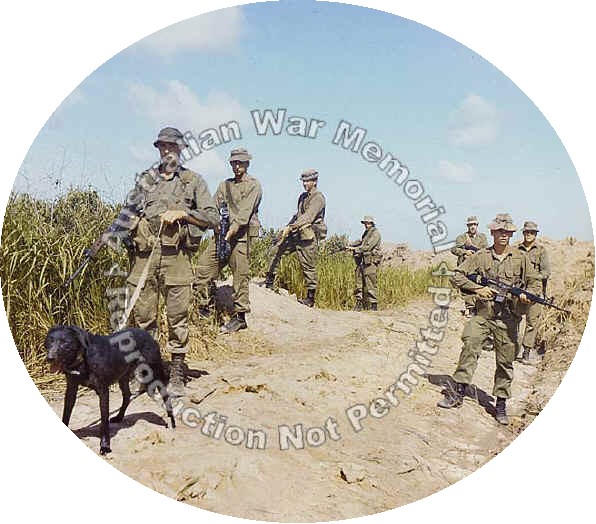
|
| South
Vietnam. July
1970. The tracker team of 2RAR
/NZ (ANZAC) (the ANZAC Battalion comprising 2nd Battalion, the Royal
Australian Regiment and a component from the 1st Battalion, Royal New
Zealand Infantry Regiment), is led out on patrol by tracker dog, Milo,
from Fire Support Base (FSB) Tess, eight miles west of the 1st
Australian Task Force (1ATF) Base at Nui Dat. FSB Tess is the current
operational base for the battalion. Behind Milo on the left are:
Private (Pte) Ron Johnson, 19, from Newcastle, NSW; Pte Kevin
Lawrence, 23, from Sydney, NSW; Pte George Cottam, 22, from Nagambie,
Victoria; and Pte Robert Payne, 22, from South Perth, WA. On the
right, from the front, are: Corporal Peter Clark, 19, from Dandenong,
VIC.; Pte Roy Hameister, 24, from Perth, WA; and Pte John Pigott, 22,
from Toowoomba, QLD. |
|
Dogs in the Great
War
|
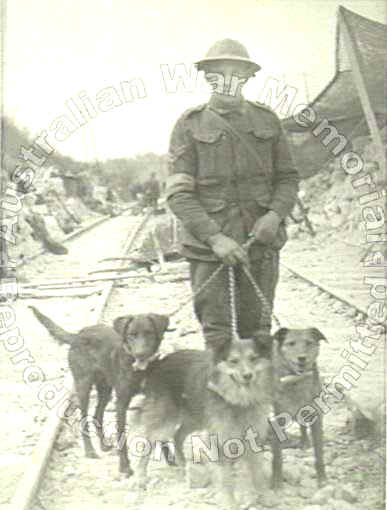 |
3133
Corporal James Coull, NCO in charge, with dogs of No. 3 Messenger Dog
Section, attached to the 4th Divisional Signal Company, in a railway
cutting near Villers-Bretonneux while operating with 12th Brigade.
The Section comprised sixteen
men and fifty messenger dogs. These
dogs worked with fairly successful results, but were never solely
relied on in sending messages. Left to right: War Dog 103 Nell, a
Cross Setter; 102 Trick, a Collie; 101 Bullet, an Airedale. All three
dogs were very efficient in message carrying and saw service with the
2nd, 4th and 5th Australian Divisions, also with Divisions of the
British 8th Corps (Imperial). 102 Trick was particularly efficient and
was well known by all Brigades of above-named Divisions. He was
specially mentioned by Signal Officer of 2nd Division for good work at
Rubimont, near Heilly.
|
| Dogs
in World War 2 |
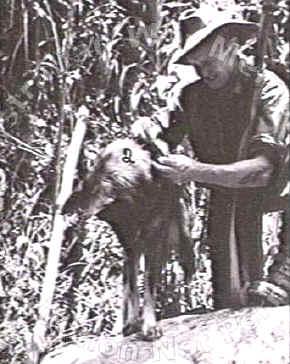 |
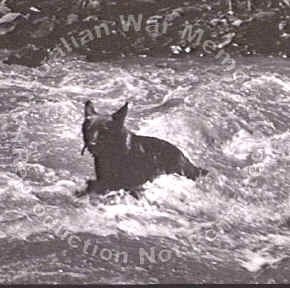 |
| Faria
Valley, New Guinea. 1943-10-20.
SX17682 private J. G. Worchester of the 2/27th Australian Infantry
Battalion and his dog "Sandy". "Sandy" was one of
the many dogs trained by the United States Dog Detachment for the
Australian Army, for use as scouts and messengers for forward patrols.
Private Worchester can be seen placing a message in the dog's collar. |
Faria
Valley, New Guinea.
1943-10-20. "Sandy"
a dog trained by the United States Dog Detachment for the 2/27th
Australian Infantry Battalion, crossing a river on his way back to
headquarters with a message in his collar |
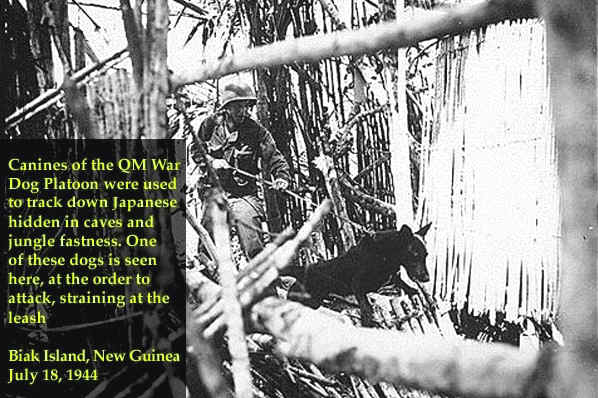 |
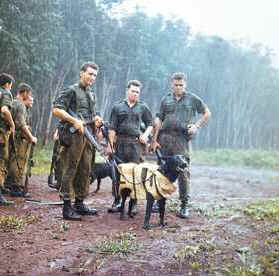 |
Soldiers from 7RAR's Fire Assault Pl Tracking Team
wait through a tropical downpour on the battalion helipad, Porky
Seven, to carry out helicopter winching training with tracker dogs
Tiber and Justin. Tiber is wearing a special harness allowing the
tracking dogs to be inserted or extracted from the jungle by the
helicopter winch.
AWM EKN/76/0097/VN.
|
A combat tracking team is choppered into a recent
contact site to begin following up wounded Viet Cong. AWM
P0800/72/30
|
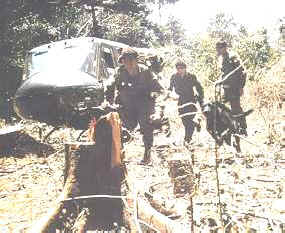
|
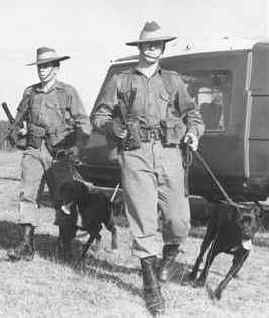 |
Pte Chad Sherrin, left, with Brutus and Pte Wayne
Handley with Nero set out for a tracking exercise before the
battalion's deployment to South-East Asia.
Photo courtesy of Chad Sherrin.
|
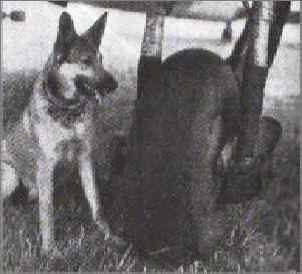 |
Dogs
were first introduced into the Royal Australian Air Force
during 1943, when asset security was provided by untrained and
extremely savage dogs, which were placed loose inside
warehouses and compounds, tied to aircraft or fixed to long
lines, so they could run back and forth along a fence lines
etc.
It wasn't until August 26,
1954, ten years later, that trained patrol dogs and K9
handlers were finally introduced into the RAAF; and that the
RAAF Police Dog Training Centre was formed, at No. 1 Central
Reserve, RAAF Albury, New South Wales.
|
Today, the Royal Australian
Air Force, is the largest single corporate user of military
working dogs in Australia. Its 195 MWD have an important role in the
security of high-value RAAF assets at some 12 bases and establishments
located across Australia. The RAAF currently has about 180 trained dog
handlers on active duty.
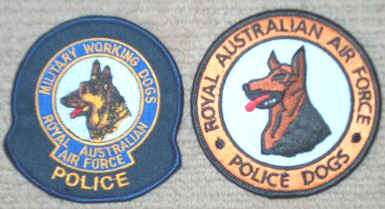 |
The RAAFs basic preparation and dog training course is four months,
and is conducted at the Security (Dog Training) and Fire School,
located in Amberley, Queensland.
The School is also responsible for
training all service dogs used by all of its Defence Forces. |
Breeds
used are German Shepherds and mixes, and Labs, although they
are moving towards replacing the German Shepherd, with the
shorter hair Belgian Shepherd, who is better able to handle
the extreme temperatures at some air bases, and installations.
The first Australian Army and Navy Police Dog sections were
introduced in 1977, and became fully operational in 1978.
It should be noted, that
units of the Australian Army were using patrol and tracker
dogs, as far back as the Korean War, the Malayan Emergency,
and in Borneo.
Dog training then, was
conducted by members of the British Army's RAVC and SAS units.
|
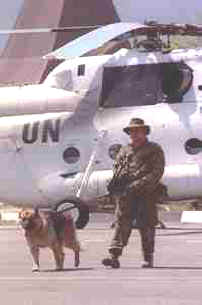 |
1967 during the Vietnam War,
the Australian Army provided two units of Tracker Dogs, that were
trained, by the Tracking Wing, of the School of Infantry, at Ingleburn
a small military base located outside of Sydney, in 1966. The Tracking
Wing was closed by the government when Australia's involvement
in Vietnam ended.
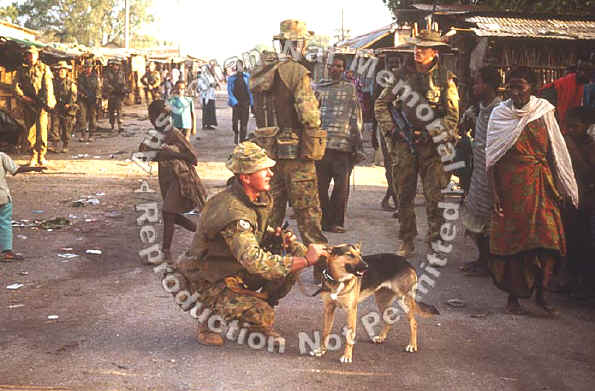 |
| Baidoa,
Somalia. 1993-03-22. Lieutenant
Bob Worswick (behind dog handler), and Corporal T. R. Connor,
members of 2 Platoon, A Company, 1st Battalion, The Royal
Australian Regiment (1RAR), and a dog handler from 3 Combat
Engineer Regiment, using one of their three dogs during a foot
patrol through the native quarter. They are serving with the
Australian contingent to the Unified Task Force in Somalia (UNITAF).
|
Military working dogs of the
Australian Defence Forces have served since the eighties, under the
United Nations' flag in: Sinai, Cambodia, Bouganville, and today in
Kosovo and East Timor with Anzac. Australia's combined military
services use more MWD today, than at anytime in its history!
more detail available at
http://www2.ozland.net.au/users/marshall/Trackers/trackers.htm
|
|
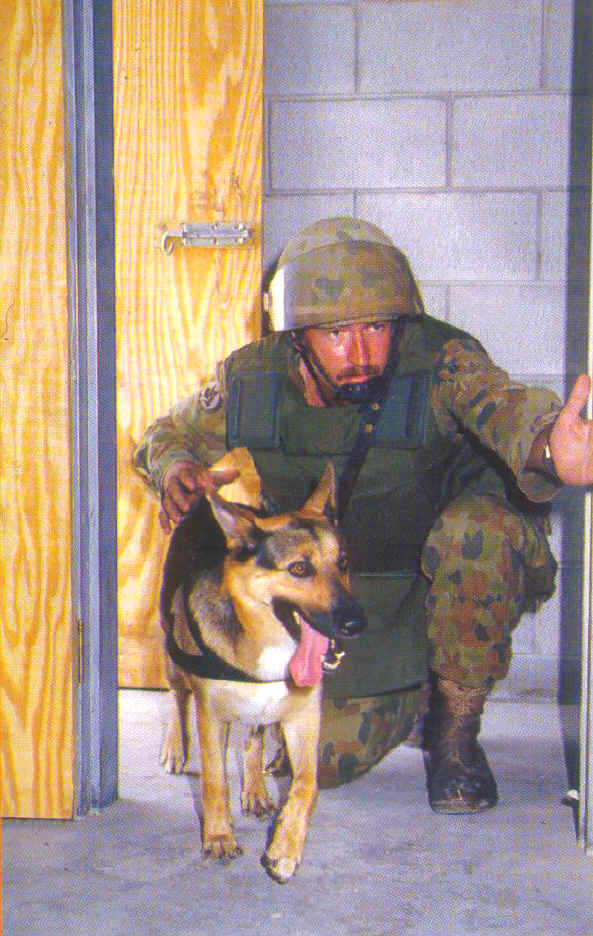
|
| This
Digger and his dog form part of a Royal Australian Engineer High-risk
Search Team. They are an explosive-detection team. from
Army Magazine of June 1995 |
|
In memory of our
"tracker dogs"
By Robert McLean.
A war memorial with an unusual twist, sits in a
small park overlooking the seas of the South Pacific Ocean at
Alexander Headland.
The memorial recognizes Australians who represented our country in
confrontations that plagued South Vietnam from 1967 until 1971 -
unlike most memorials which acknowledge the efforts of people, this
one is for our four footed friends, dogs.
The inscription says:
War dog memorial
Dedicated to the Australian tracker dogs the served in South Vietnam -
1967-1971.
They did not return from the war
Ceasar, Janus, Juno, Marcian, Mila, Trajan, Cassius, Julian, Justin,
Marcus, Tiber.
-
Down jungle
tracks, through shot and shell,
-
ears pricked,
keen sense of smell;
-
our tracker dogs
with care and poise,
-
alert to ambush,
foreign noise;
-
never whimper,
whine nor bark,
-
their service
honoured with this plaque,
-
no medals pinned
to hairy chest,
-
they stayed
behind, they were the best.
Few Australians would
even know we had tracker dogs in our armed forces, and probably even
fewer would know they played their part in South Vietnam.
Interestingly those who visit Alexander Headland on Queensland's
Sunshine Coast and admire the vista from a park overlooking the ocean
would know, as they are in the company of at least the spirits of
Australia's tracker dogs.
A simple war memorial for our truly unsung heroes in a truly beautiful
spot.
|
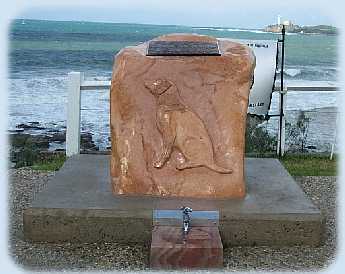 |
The
monument recognises the enormous contribution by the war dogs that
saved countless soldiers lives in Viet Nam.
The monument was unveiled at a
ceremony on Saturday 7th April 2001 at 12 noon at The Bluff,
Alexandra Headland, Sunshine Coast, Queensland, Australia.
At the base of the rock at the
foot of the carving is a drinking trough where local dog owners can
water their animals while walking their dogs. http://www.rar.org.au/dogs
|
|